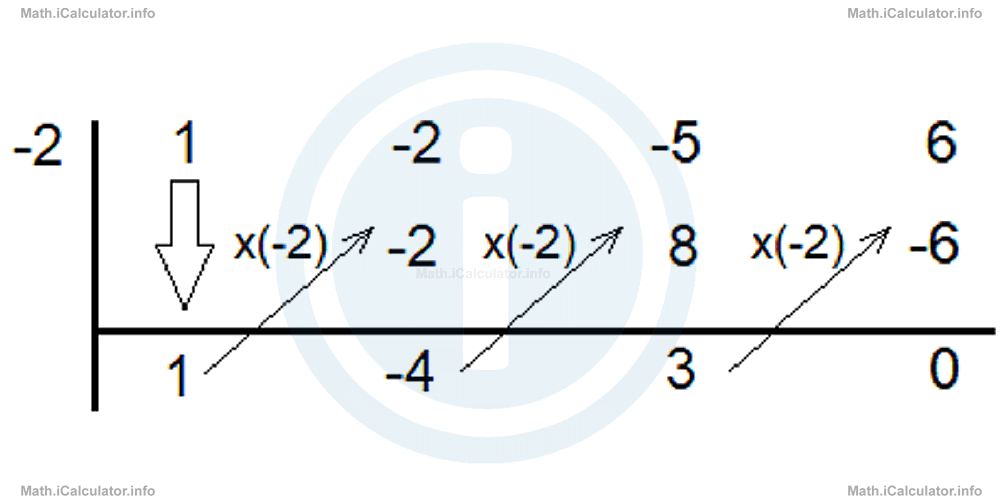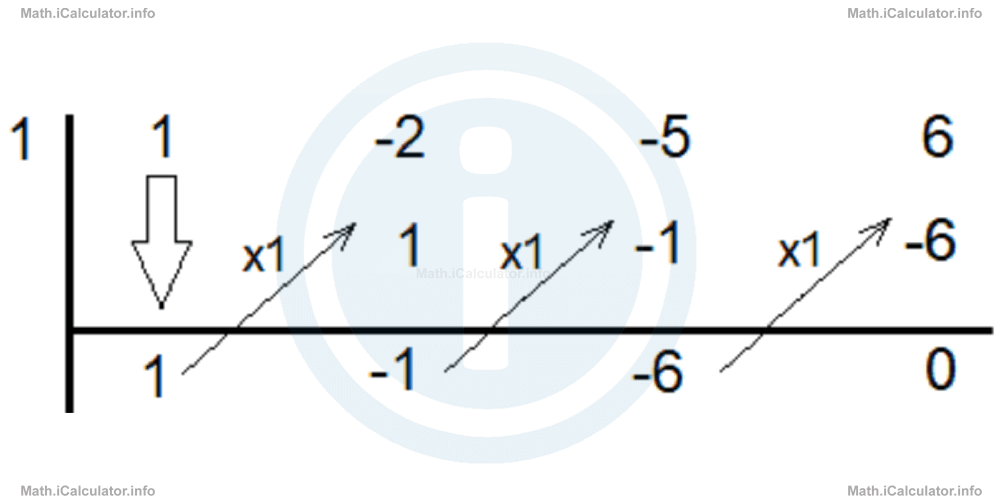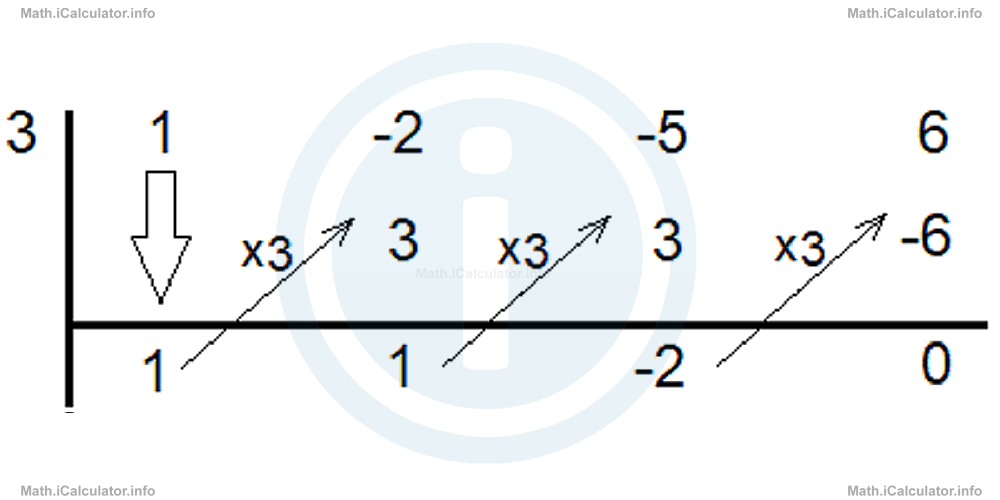Menu
Math Lesson 11.3.5 - How to Solve Polynomial Equations
Please provide a rating, it takes seconds and helps us to keep this resource free for all to use
Welcome to our Math lesson on How to Solve Polynomial Equations, this is the fifth lesson of our suite of math lessons covering the topic of Solutions for Polynomial Equations, you can find links to the other lessons within this tutorial and access additional Math learning resources below this lesson.
Solving Polynomial Equations
So far, we have explained how to find all rational roots of a polynomial P(x). In fact, they represent nothing more but the solutions of the corresponding polynomial equation P(x) = 0. Hence, the above procedure is also used to solve polynomial equations of whatever degree. The only restriction is that all coefficients and the constant of the given polynomial must be integers. Otherwise, the equation must be solved using the computerized methods.
In short, all polynomial equations are solved by combining the Rational Root Theorem and the Synthetic Division Method, as explained earlier in this tutorial. Let's summarize everything through an example.
Example 2
- Solve the following polynomial equation x3 - 2x2 - 5x + 6 = 0
- Write all possible factorisations for the left side of this equation.
Solution 2
- Solving the above polynomial equation means finding all zeroes of the polynomial on the left side of the equation.
The left part of this equation represents the third-degree polynomialP(x) = x3 - 2x2 - 5x + 6where an = 1 and a0 = 6.
From the Rational Root Theorem, we know that all possible rational roots of a polynomial (if they exist) are in the form p/q, where p is a factor of a0 and q is a factor of an.
The possible factors of a0 are ± 1, ± 2, ± 3 and ± 6, and those of an = ± 1. Thus, we obtain the following list of the possible zeroes of the polynomial:p/q = ± 1/± 1; ± 2/± 1; ± 3/± 1; ± 6/± 1After removing the duplicates, we can list eight possible roots for the polynomial P(x). They are -6, -3, -2, -1, 1, 2, 3 and 6.
Now, let's see which of them is/are the true zeroes of the polynomial. Since the polynomial is of the third degree, we have three zeroes at maximum out of eight possible ones.
Substituting each of them in the polynomial P(x) = x3 - 2x2 - 5x + 6 yieldsP(-6) = (-6)3 - 2 ∙ (-6)2 - 5 ∙ (-6) + 6
= -216 - 2 ∙ 36 - 5 ∙ (-6) + 6
= -216 - 72 + 30 + 6
= -252P(-3) = (-3)3 - 2 ∙ (-3)2-5 ∙ (-3) + 6
= -27 - 2 ∙ 9-5 ∙ (-3) + 6
= -27 - 18 + 15 + 6
= -24P(-2) = (-2)3-2 ∙ (-2)2 - 5 ∙ (-2) + 6
= -8 - 2 ∙ 4-5 ∙ (-2) + 6
= -8 - 8 + 10 + 6
= 0P(-1) = (-1)3 - 2 ∙ (-1)2 - 5 ∙ (-1) + 6
= -1 - 2 ∙ 1 - 5 ∙ (-1) + 6
= -1 - 2 + 5 + 6
= 10P(1) = (1)3 - 2 ∙ (1)2 - 5 ∙ (1) + 6
= 1 - 2 ∙ 1 - 5 ∙ 1 + 6
= 1 - 2 - 5 + 6
= 0P(2) = (2)3 - 2 ∙ (2)2 - 5 ∙ (2) + 6
= 8 - 2 ∙ 4 - 5 ∙ 2 + 6
= 8 - 8 - 10 + 6
= -4P(3) = (3)3 - 2 ∙ (3)2 - 5 ∙ (3) + 6
= 27 - 2 ∙ 9 - 5 ∙ 3 + 6
= 27 - 18 - 15 + 6
= 0P(6) = (6)3 - 2 ∙ (6)2 - 5 ∙ (6) + 6From the operations above it is clear that x = -2, x = 1 and x = 3 are the solutions (roots) of the given polynomial equation, as only for those we have P(x) = 0.
= 216 - 2 ∙ 36 - 5 ∙ 6 + 6
= 216 - 72 - 30 + 6
= 120 - We have to use the Synthetic Division Method to find all possible factorisations of the polynomial on the left side of the equation. Obviously, we will consider only the already found roots for this purpose. Thus, using the coefficients 1, -2, -5 and 6 for the upper row and the roots of the equation on the left yields:
- For the root x = -2:
 The numbers in the last row (except the rightmost one that gives the remainder) represent the coefficients of the long expression in the brackets. The other expression involves the zero of the polynomial. Hence, we obtain P(x) = x3 - 2x2 - 5x + 6 = (x + 2) ∙ (x2 - 4x + 3)
The numbers in the last row (except the rightmost one that gives the remainder) represent the coefficients of the long expression in the brackets. The other expression involves the zero of the polynomial. Hence, we obtain P(x) = x3 - 2x2 - 5x + 6 = (x + 2) ∙ (x2 - 4x + 3) - For the root x = 1:
 The numbers in the last row (except the rightmost one that gives the remainder) represent the coefficients of the long expression in the brackets. The other expression involves the zero of the polynomial. Hence, we obtain P(x) = x3 - 2x2-5x + 6 = (x - 1)(x2 - x - 6)
The numbers in the last row (except the rightmost one that gives the remainder) represent the coefficients of the long expression in the brackets. The other expression involves the zero of the polynomial. Hence, we obtain P(x) = x3 - 2x2-5x + 6 = (x - 1)(x2 - x - 6) - For the root x = 3:
 The numbers in the last row (except the rightmost one that gives the remainder) represent the coefficients of the long expression in the brackets. The other expression involves the zero of the polynomial. Hence, we obtain P(x) = x3 - 2x2 - 5x + 6 = (x - 3)(x2 + x - 2)
The numbers in the last row (except the rightmost one that gives the remainder) represent the coefficients of the long expression in the brackets. The other expression involves the zero of the polynomial. Hence, we obtain P(x) = x3 - 2x2 - 5x + 6 = (x - 3)(x2 + x - 2)
- For the root x = -2:
More Solutions for Polynomial Equations Lessons and Learning Resources
Whats next?
Enjoy the "How to Solve Polynomial Equations" math lesson? People who liked the "Solutions for Polynomial Equations lesson found the following resources useful:
- Solving Polynomial Equations Feedback. Helps other - Leave a rating for this solving polynomial equations (see below)
- Polynomials Math tutorial: Solutions for Polynomial Equations. Read the Solutions for Polynomial Equations math tutorial and build your math knowledge of Polynomials
- Polynomials Video tutorial: Solutions for Polynomial Equations. Watch or listen to the Solutions for Polynomial Equations video tutorial, a useful way to help you revise when travelling to and from school/college
- Polynomials Revision Notes: Solutions for Polynomial Equations. Print the notes so you can revise the key points covered in the math tutorial for Solutions for Polynomial Equations
- Polynomials Practice Questions: Solutions for Polynomial Equations. Test and improve your knowledge of Solutions for Polynomial Equations with example questins and answers
- Check your calculations for Polynomials questions with our excellent Polynomials calculators which contain full equations and calculations clearly displayed line by line. See the Polynomials Calculators by iCalculator™ below.
- Continuing learning polynomials - read our next math tutorial: Rational Expressions
Help others Learning Math just like you
Please provide a rating, it takes seconds and helps us to keep this resource free for all to use
We hope you found this Math tutorial "Solutions for Polynomial Equations" useful. If you did it would be great if you could spare the time to rate this math tutorial (simply click on the number of stars that match your assessment of this math learning aide) and/or share on social media, this helps us identify popular tutorials and calculators and expand our free learning resources to support our users around the world have free access to expand their knowledge of math and other disciplines.